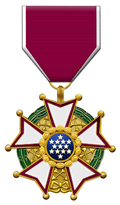| Legion of Merit | |
|---|---|
 | |
| Type | Order of merit |
| Awarded for | Exceptionally meritorious conduct in the performance of outstanding services and achievements |
| Presented by | United States Department of the Army [1] United States Department of the Navy [2] United States Department of the Air Force [3] United States Department of Homeland Security [4] |
| Eligibility | Members of the Uniformed Services of the United States and political and military leaders of allied states |
| Reverse |  |
| Status | Currently awarded |
| First award | 1942 |
| | |
| Precedence | |
| Next (higher) | Defense Superior Service Medal |
| Next (lower) | Distinguished Flying Cross |
The Legion of Merit (LOM) is a military award of the United States Armed Forces which is given for exceptionally meritorious conduct in the performance of outstanding services and achievements. The decoration is issued to members of the eight uniformed services of the United States [5] as well as to military and political figures of foreign governments.
Contents
The Legion of Merit (Commander degree) is one of only two United States military decorations to be issued as a neck order (the other being the Medal of Honor), and the only United States military decoration that may be issued in degrees (much like an order of chivalry or certain orders of merit), although the degrees including a neck ribbon are only awarded to non-U.S. nationals. [6] [7]
The Legion of Merit is seventh in the order of precedence of all U.S. military awards and is worn after the Defense Superior Service Medal and before the Distinguished Flying Cross. [8] In contemporary use in the U.S. Armed Forces, the Legion of Merit is typically awarded to Army, Marine Corps, Air Force, and Space Force general officers and colonels, and Navy and Coast Guard flag officers and captains occupying senior command or very senior staff positions in their respective services. It may also be awarded to officers of lesser rank, senior warrant officers (typically in command positions at the rank of chief warrant officer 5), and to very senior enlisted personnel (typically in the rank of command sergeant major and Sergeant Major of the Army in the Army, fleet master chief petty officer and Master Chief Petty Officer of the Navy in the Navy, command chief master sergeant and Chief Master Sergeant of the Air Force in the Air Force, command chief master sergeant and Chief Master Sergeant of the Space Force in the Space Force, and Sergeant Major of the Marine Corps in the Marine Corps), but these instances are less frequent, typically by exception, and the circumstances vary by branch of service.
Authority to award the Legion of Merit is reserved for general officers and flag officers in pay grade O-9 (i.e., lieutenant general, vice admiral) and above, civilian Department of Defense personnel at assistant service secretary or Assistant Secretary of Defense level and above, or equivalent secretary-level civilian personnel with the Department of Homeland Security with direct oversight of the U.S. Coast Guard.









